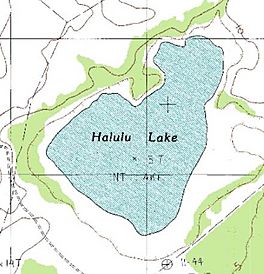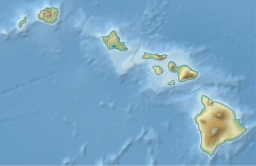Halulu Lake facts for kids
Quick facts for kids Halulu Lake |
|
|---|---|
 |
|
| Location | Niʻihau |
| Coordinates | 21°52′05″N 160°12′25″W / 21.868°N 160.207°W |
| Catchment area | 182 acres (74 ha) |
| Basin countries | United States |
Halulu Lake is a special lake found in the middle-south part of Niʻihau island. Niʻihau is the smallest island in Hawaii where people live. This lake is the biggest natural lake in the Hawaiian Islands that doesn't dry up completely. Two other lakes, Hālaliʻi Lake (also on Niʻihau) and Keālia Pond (on Maui), are sometimes larger, but they can dry out.
Contents
About Halulu Lake
Halulu Lake changes size depending on the weather. During the rainy season, it can be about 182 acres (74 ha) big. But when the island has dry weather, the lake gets smaller. This is because the water evaporates, or turns into vapor and goes into the air. Some people say the lake can even reach 371 acres (150 ha) in size.
Why is it Called Halulu?
The name "Halulu" comes from the land area around the lake. Experts in the Hawaiian language, like Mary Kawena Pukui, Samuel H. Elbert, and Esther T. Mookini, believe the name might come from a mythical bird. This bird, called halulu, was a giant, man-eating bird in Hawaiian mythology. The names Hālaliʻi and Halulu were also used for important Hawaiian chiefs on Niʻihau long ago.
Halulu Lake and World War II
Before the attack on Pearl Harbor during World War II, the owner of Niʻihau, Aylmer Francis Robinson, took action. He used mules and tractors to dig trenches in the lakes and surrounding lands. He did this to stop Japanese planes from landing on the island and using it as a military airfield.
These trenches played a role in the Niihau incident. A Japanese pilot, Shigenori Nishikaichi, crash-landed on the island during this time. Many of the furrows, or dug lines, can still be seen on Niʻihau today.
Animals of Halulu Lake
Halulu Lake is a great home for many Hawaiian bird species. These include the ʻalae keʻokeʻo, which is also known as the Hawaiian coot. You can also find the aeʻo, or Hawaiian stilt, and the koloa maoli, which is the Hawaiian duck. These birds rely on the lake's natural wetlands for their habitat.
Mullet Fish in the Lake
The lake is also home to mullet fish. These fish naturally swim into the lake from the ocean when they are young. They travel through underground lava tubes to get there.
In ancient Hawaii, there was a special rule called a kapu. This rule meant that Hawaiians were not allowed to catch fish in the lake except during certain harvest times. Today, people on Niʻihau still use the lakes and ponds to raise mullets. They bring baby mullets, called pua, from the sea in barrels. When the fish grow bigger, they are sold in markets on Kauaʻi and Oʻahu.


